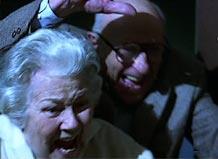Uneasy Rider

Tom Andersen is a wonderous and insightful professor of film history and filmmaking. His latest movie opened a year ago, (although I hadn’t seen it until last week) entitled, Los Angeles Plays Itself, (which sounds all too close to Los Angeles Gets Played) is an indulgent documentary on the varied ways that Los Angeles is depicted spatially and culturally in films. Interestingly the film was being screened at the Villa Aurora, a Spanish style house built by a German Jewish architect in the Pacific Palisades area of LA. The people who gathered to watch it were a mix of elderly women who heckled people as they took their seats, middle-aged art film hangers-on, young urban professional artists mostly from Germany and Austria and a handful of self-appointed agents of the city, where I fit into that mischung is embarrassing and unnecessary to admit.
The clips of films about LA are well chosen and cut/narrated in a manner that betrays how passionate Andersen is about the city. Although I live there now, I’m not from LA. It’s very much a distanced (there) place, for me presently and I should note I get lost here daily. Encke King says in his narration for the film, that LA is the most used city in film, (this can't be true presently). Andersen goes back to the early days of the medium and proves that the renaming of the city in (a particular early film that I don't recall the name of) has been a deliberate effort made to fictionalize the city in films. The streets, buildings, suburbs fall out of order once on celluloid and are reassembled to make the war hospital scene more civilized and orderly once set in the historic Bradbury building, car chases more destructive or the romantic drive more picturesque. The trouble is that we’ve got a lot more of everything here in LA. More roads of all different types, more natural variations in terrain, more cars…there’s a lot to work with. Let’s face it, this town and it’s suburbs are a film scouts’ dream. It’s clear however that Andersen feels that films have generally betrayed LA in their portrayal of it.
Note to Linklater: Feel free to send Hawke and Delpy here to shoot the sequel to Before Sunrise and Before Sunset, call it 'After noon' perhaps. It will have to be set in some sort of motor vehicle as they certainly can’t walk to anything in a timely fashion. Then again perhaps this city is perfect for a Linklater film as his characters never seem to be in a rush to get anywhere and in one particular film never make it out of a single room.
Here’s my point, films in their very nature, unless they are a documentary, do not claim to accurately depict space or time, (except for in the case of Time Code). Does it matter whether Girl 6 lived in Bed Stuy or Harlem? We don’t read a book like Miller’s Sexus and get irritated because he didn’t specify which building ‘The Cosmodemonic Telegraph Company’ does business out of. It’s a work of fiction composed by an artist who uses words rather than pictures as a cinematographer does. Why should a film run on any logic other than it’s own? Had The Terminator’s fight and chase scenes traversed an actual single location would it have been an art-house classic? Hell, no.
As I stated earlier, I’m not from LA. I had a different idea of what it was/is from watching films so studiously. No, I didn’t understand that it would appear as it does in film in reality, (I did hope that they had better public transit than the non-existent system in movies). Most of the films that receive mass distribution that take place in LA, (and elsewhere for that matter) are not made for the people who make films themselves or are car-less and working three jobs to stay afloat. They’re made for one of the women at the screening who ‘doesn’t want people to see LA that way, that’s not what my life is like. I have to drive everywhere, I have appointments and professional obligations’. Films aren’t about her either are they? Then again, I don’t watch all the Loews mull. Is Andersen guiding those so inclined to make the contemporary equivalent to Woodberry's Bless Their Little Hearts...? quite possibly
Perhaps LA needs more directors like the Hughes brothers. As Besson and LeMonnier went underground and hitched across the countryside of France we need more films about LA traveling off of the highways aboard a Lexus and onto them as migrant workers riding in the back of pickups like shrubs from the Home Depot. A film maker to feature LA's dark, stinking alleys, turnstiles without fareboxes, miles of fenced borders and leagues of routes and highways.


1 Comments:
I'd like to add to your discussion of spatial and temporal relations in films: The only times people should be virulently discussing the faux pas that will always occur between the two is when the error is so erroneous and large that non-natives will recognize them and will mentally be taken out of the movie. Say, if a car chase blows past the Merrill Lynch Bull in New York then rounds a corner in Toronto. Or (and I actually saw this one) a helicopter shot which intends to showcase a Neanderthal village captures sweeping shots of a spectacular valley that unfortunately has been criss-crossed with crew members' pick-up tracks.
Oh, and as for Linklater. He needs to return to his roots and come back to Austin. He can bring the Wilson boys and Wes Anderson with him, too. :-P
P.S. As for spammers, if you turn on the word verification in your comment settings page it will be harder for them to get through.
Post a Comment
<< Home